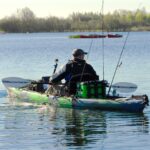Kayaking is one of the outdoor sports. The sport of kayaking is most popular across America and Europe, and its demand is increasing daily. Kayaking has also become an extreme sport.
However, Can you use a whitewater kayak on a lake? Through this blog post, I will help you navigate the waters and make the most of your experience.
Also, I will tell you more about how safe whitewater kayaking is for you and what techniques to use to kayak safely. Join me and shed light on this exciting topic.
Can you use a whitewater kayak on a lake?
You can use a whitewater kayak on a lake, but it’s essential to consider a few things. Generally, whitewater kayaks are usually designed for rough water.
Also, whitewater kayaks are generally smaller and less stable. This means that whitewater kayaks will be more susceptible to waves and storms in large bodies of water such as lakes. This is especially true if you have no kayaking experience.
However, sometimes, using a whitewater kayak can be a better way to kayak on a lake. For example, a whitewater kayak may be a good option for a more challenging kayaking experience with waves and storms.
Additionally, if you are an experienced kayaker aware of your limits, you can safely kayak the lake using a whitewater kayak.
Finally, whitewater kayaks are generally more expensive than other types of kayaks. Buying a regular kayak may be more expensive if you only plan on kayaking on the lake occasionally.
Is kayaking dangerous in a lake?
Generally, lake kayaking is safe, but there are some dangers you should be aware of. The risks can vary depending on the location of the lake, the weather, and your experience level.
One of the main hazards is falling into the water. This can be especially dangerous in cold water, as hypothermia can set in quickly. That’s why always wearing a life jacket is essential, even if you’re swimming.
Also, another risk is storms and waves. The larger the lake, the greater the storm risk. If you see a storm coming, try to get to the lake.
Ultimately, there are some risks depending on your experience level. If you are not an experienced kayaker, it is best to go with an experienced person or hire a guide.
If you are careful and aware of the risks, lake kayaking can be a safe and enjoyable experience.
How do you sit in a whitewater kayak?
Can you use a whitewater kayak on a lake? Whitewater kayaking is an exciting experience, but proper seating is essential. If you don’t sit the kayak properly, you can end up in the water, resulting in many problems.

Follow the instructions below for a safe and comfortable experience:
1. Access Kayak
First, place the kayak on flat ground and stand facing forward. Then, slowly enter the cockpit and sit with your back straight. Your knees should be slightly bent, and your ankles should be flat inside the kayak.
2. Ensure stability
Hold the sides of the kayak firmly. Press firmly against the inside of the kayak with your heel. This will help you establish a strong connection with the kayak.
3. Comfortable location
Keep your hips firmly on the back of the kayak. Then, keep your back straight and shoulders relaxed. Place your hands naturally on either side of the kayak.
4. Ensure protection
Wear a life jacket and secure yourself by properly fastening the straps.
Get the necessary safety training and kayaking with experienced people. And wear appropriate clothing when entering cold water. Although I discussed above and tried to inform you, Can you use a whitewater kayak on a lake?
By following these simple procedures, you can safely and comfortably enjoy a whitewater kayaking experience.
How to carry a whitewater kayak?
Whitewater kayaks can be relatively large and heavy, so proper portability is essential. It helps to avoid harm and protect yourself and others from injury. With a few tricks, you can carry a whitewater kayak without risk.
Here are some tips you can follow to carry your whitewater kayak comfortably:
1. Reduce waistline stress
Use the carrying straps that come with the kayak. Place them on either side of the kayak and adjust over your shoulder. This will reduce the strain on your waist and make carrying the kayak easier.
2. Hold securely
Hold tight just above and below the kayak’s cockpit. This will keep the kayak securely in place and prevent accidental falls.
3. Keep your back straight.
When carrying the kayak, keep your back straight and knees slightly bent. This will help maintain proper posture and reduce back strain while carrying heavy objects.
4. Keep the vision ahead.
Look straight ahead and focus ahead. This will help you avoid any obstacles in your path and protect yourself and others from injury.
Can you use a whitewater kayak on flat water?
Can you use a whitewater kayak on a lake? You can use whitewater kayaks on flat water. However, it won’t be as easy or fast as other kayaks.
Whitewater kayaks are designed for steep rivers and waves so that they can be slow on flat water. Also, these kayaks are more stable than other kayaks.
However, they require much more power to run on flat water. Although confirmed above, Can you use a whitewater kayak on a lake?
If you plan to use a whitewater kayak on flat water, ensure it’s the right size for comfortable adjustments. You can use a small fin to increase your speed in flat water slightly.
Frequently Asked Questions
Can you kayak in jeans?
Jeans should not be kayaked after. Jeans absorb water and become heavy, making you uncomfortable and making the kayaks difficult. Also, if you fall into the water, jeans will cool you and increase the risk of hypothermia.
Do you need kayak shoes?
You must not wear kayak shoes for kayak. However, they can provide some benefits. The kind of shoes you wear for a kayak depends on your preference and the kayaking you are doing.
Related Post
How to get into whitewater kayaking
Do kayak paddles float
Can You Kayak At Night
Is It Safe To Kayak Alone
Can You Fish In A Sit In Kayak
Final Words
Typically, whitewater kayaks are designed specifically for navigating fast-moving rivers and rapids, such as a shorter length, rounded hull, and increased maneuverability.
On the other hand, lakes offer calm and flat water conditions, which may not fully utilize the capabilities of whitewater kayaks. In addition, I informed you in the discussion Can you use a whitewater kayak on a lake?
However, the design of whitewater kayaks can make them less stable and more challenging to paddle in calm water, leading to a less enjoyable experience for the paddler. I hope you have a lot of fun operating whitewater kayaks in the future.












